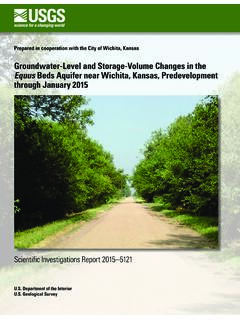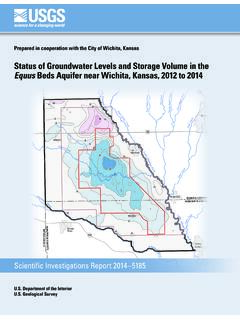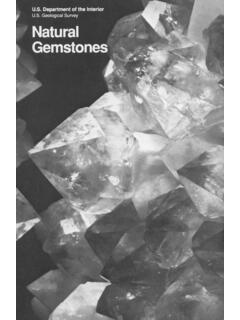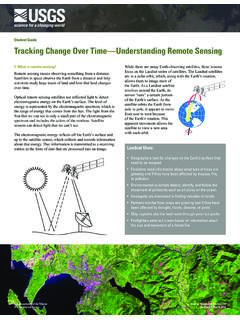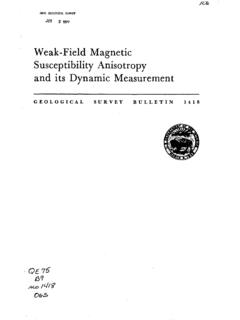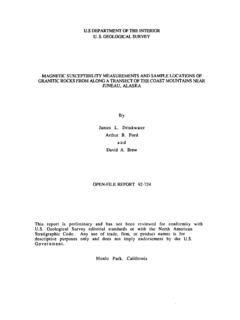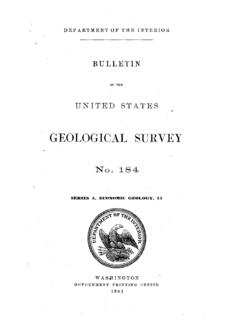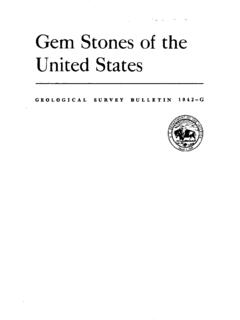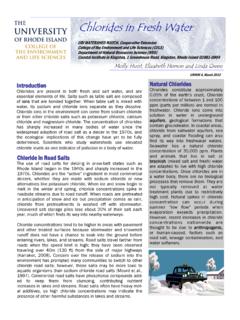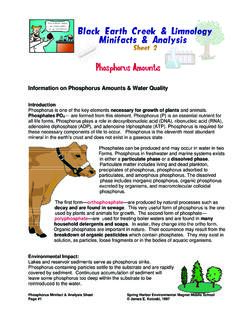Transcription of Chemistry of Iron in Natural Water - USGS
1 Chemistry of iron in Natural WaterGEOLOGICAL SURVEY Water -SUPPLY PAPER 1459 UNITED STATES GOVERNMENT PRINTING OFFICE, WASHINGTON : 1962 UNITED STATES DEPARTMENT OF THE INTERIOR STEWART L. UDALL, SecretaryGEOLOGICAL SURVEY Thomas B. Nolan, DirectorThe Geological Survey Library has cataloged this publication as follows Geological of iron in Natural Water . Washington, Govt. Print. Off., , 268 p. illus., diagrs., tables. 23 cm. (Its Water -supply paper 1459)Issued as separate chapters Water Analysis. 2. iron . I. Title. (Series)CONTENTS[The letters in parentheses preceding the titles designate separately published chapters](A) Survey of ferrous-ferric chemical equilibria and redox potentials, by Page J.
2 D. Hem and W. H. Cropper_____ 1(B) Restraints on dissolved ferrous iron imposed by bicarbonate redoxpotential, and pH, by J. D. Hem_____ 33(C) Some chemical relationships among sulfur species and dissolvedferrous iron , by J. D. Hem_ _____ 57(D) Complexes of ferrous iron with tannic acid, by J. D. Hem_____ 75(E) Coprecipitation effects in solutions containing ferrous, ferric, andcupric ions, by J. D. Hem and M. W. Skougstad_____ 95(F) A survey of pertinent biochemical literature, by Eugene T. Oborn. __ 111 (G) iron content of selected Water and land plants, by Eugene T. Oborn_ 191 (H) Microbiologic factors in the solution and transport of iron , by EugeneT. Oborn and J. D. 213(I) Some effects of the larger types of aquatic vegetation on iron contentof waterj by Eugene T.
3 Oborn and J. D. Hem_ _____ 237 Survey of Ferrous-Ferric Chemical Equilibria and Redox PotentialsBy J. D. HEM and W. H. CROPPERCHEMISTRY OF iron IN Natural WATERGEOLOGICAL SURVEY Water -SUPPLY PAPER 1459-AUNITED STATES GOVERNMENT PRINTING OFFICE, WASHINGTON : 1959 UNITED STATES DEPARTMENT OF THE INTERIOR FRED A. SEATON, SecretaryGEOLOGICAL SURVEY Thomas B. Nolan, DirectorFor sale by the Superintendent of Documents, Government Printing Office Washington 25, - Price 15 cents (paper cover)CONTENTSPawAbstract___ ___-___-__--_-__---_-_____-_____--_-_-__ 1 Introduction _____ 1 General features of iron chemistry_____ 2 Theoretical approach to iron Chemistry _____ 3 Form of iron in solution_____ 3 Stability-field 4 Possible existence of Fe(OH)3 aqueous and Fe(OH)
4 2 aqueous____ 8 Maximum solubility of iron_____ 10 Occurrence of ferrous iron in Natural waters,_____ 10 Experiments with solutions of ferric and ferrous 12 Use of Eh and pH measurements to evaluate iron systems_____ 13 Origin of ferrous iron in water_____ 16 Computation of Eh in ground- Water aquifers_____ 17 Experiments with synthetic Water 20 Effects of other dissolved constituents on ferrous iron _____ 22 Occurrence of ferric iron in Natural waters_____-_-____ 23 Suspended ferric iron_____ 23 Ferric complex 26 Laboratory procedures_____ __ _____ 28 Selected bibliography_____ 29 Index_____ 31 ILLUSTRATIONSFIGURE 1. Stability-field diagram for aqueous ferric-ferrous system 5 2.
5 Relation of total activity of iron in Water to pH and Eh__ ___ 11 TABLESTABLE 1. Equilibrium constants_____--__-__ 32. Free energy 43. Eh, pH, and ferrous ion concentration measurements on pre- pared solutions_____-_____-_____-------_ 134. Nernst equation and theoretical calculations of ferrous ionoxidized by potassium permanganate_____ 155. Ferric ion concentrations calculated by two independentmethods--_-_____--_----_---- 166. Chemical analysis, Granite spring near Boulder, Colo__-----_- 177. The stability of waters containing ferrous iron _____ 198. Eh and iron concentrations measured at various depths in lakes. 229. The nonpredictable behavior of ferric hydroxide suspensions.
6 _ _ 2510. The filtration of ferric hydroxide 2511. The stability of ferrous iron in the presence of chloride ____ 27xnCHEMISTRY OF iron IN Natural WATERSURVEY OF FERROUS-FERRIC CHEMICAL EQUILIBRIA AND REDOX POTENTIALSBy J. D. HEM and W. H. CROPPERABSTRACTA mounts of iron in solution in Natural Water at equilibrium are related to the pH and Eh of the solution. Important ionic species present include Fe+++, FeOH++, Fe(OH)+2 , Fe++, and FeOH+. A stability field diagram shows the Eh and pH values at which each of these predominates. Fe(OH)3 (aq) may be present as part of the dissolved iron in Natural Water at alkaline pH, and Fe (OH)2 (aq) may exist at pH 10 and above. The total solubility of iron at pH levels from 4 to 9 is shown graphically by seven curves for Eh values from to + The amounts of iron that theoretically could be present in solution are mostly below ppm if pH is between 5 and 8, and Eh between and The content of Fe++ could exceed 100 ppm, however, at ph 5 and Eh containing 12 to 24 ppm of iron in various proportions of Fe++ to Fe+++ were unstable when exposed to air.
7 Changes in the Eh values of these solutions, measured with the platinum and calomel electrodes, indicate that equilibrium is not reached in such mixtures at the end of a week when the initial pH is to Natural ground Water containing 16 ppm of ferrous iron when collected, and 9 artificial solutions containing from about 12 to about 26 ppm of ferrous iron at pH to , lost iron by oxidation and precipitation of ferric hydroxide at a rate governed by the diffusion of oxygen through the Water . An aliquot of the Natural Water , acidified to pH , lost no ferrous iron after 3 equilibrium is assumed in ground Water in its Natural environment, deter- minations of pH in the field and of iron concentration in samples of the Water form a basis for computing the Eh within aquifers where this property cannot be measured aerated waters whose pH is above about 5, ferric iron can be present in excess of ppm only as a suspension of oxide or hydroxide.
8 The particles may be of colloidal size or larger. Complexing effects of chloride and fluoride are important in strongly acid solutions of ferric iron , but they do not seem to have much effect on the behavior of iron in waters in the range of pH 5 to 8. Organic Bomplexing effects were not report covers a preliminary phase of research by the Geological Survey into the Chemistry of iron in Natural waters. The report provides a brief introduction to theoretical aspects of dilute aqueous12 Chemistry OF iron IN Natural Water solutions that contain iron , affords a basis for better understanding of the chemical principles which control such solutions, and illustrates the use of theory to explain observed characteristics of Natural results of further research on the occurrence of iron in Water will be covered in additional reports.
9 The laboratory work and the interpretation in this report were done in the Water Resources Division research laboratory, Denver, Colo., under the general super- vision of S. K. Love, chief, Quality of Water manuscript was reviewed by colleagues of the authors in the Geological Survey, and by others. Especially helpful suggestions were furnished by Prof. R. M. Garrels, Harvard FEATURES OF iron CHEMISTRYIron is relatively abundant in the earth's crust. Rankama and Sahama (1950) report that in igneous rocks the only metal more abundant than iron is aluminum. In this discussion, we are concerned only indirectly with the solid-state occurrence of iron in rocks. The element is a principal constituent of many igneous rocks, especially those containing basic silicate minerals.
10 Divalent iron links the chains of silicon-oxygen tetrahedra in minerals such as pyroxenes and amphiboles and links individual tetrahedra in the structure of fayalite. Trivalent iron replaces aluminum in a few silicate minerals. iron is common also in the form of oxide and rocks contain iron in various forms, but ferric oxides are perhaps the more common. Geochemical data show that iron weathered out of solid minerals is not long retained in solution in Water but is redeposited in solid oxides or hydroxides. This research is concerned primarily with the behavior of iron in occurs in two oxidation states, the divalent or ferrous form and the trivalent or ferric form. iron in aqueous solution is subject to hydrolysis.
